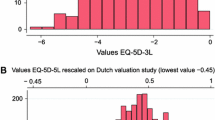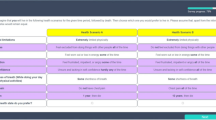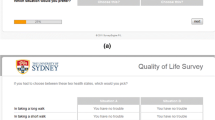Abstract
Choice-based methods have been used widely in assessing healthcare programs. This study compared the binary discrete choice experiment (DCE) and the multiprofile case of best–worst scaling (BWS) in eliciting preferences for the EQ-5D-5L. Forty-eight EQ-5D-5L health states were selected using a Bayesian efficient design and grouped into 24 pairs for the DCE tasks and 8 sets for the BWS tasks (each set has three health states). A total of 100 participants completed 12 pairs and 8 sets in a random order. A probit regression model and ranked order logistic regression model were used to estimate the latent utilities from the DCE and BWS, respectively. Both tasks were well understood by the majority of participants. The DCE tasks were relatively easier and took a shorter time to complete. The intraclass correlation coefficient (ICC) of the DCE was higher than that of the BWS. The variances associated with the latent utilities estimated from the DCE were larger than those from the BWS. The DCE is more feasible and reliable than the BWS in valuing the EQ-5D-5L. Future studies could focus on comparing the consistency and accuracy of these techniques in predicting the health utilities of the EQ-5D-5L.


Similar content being viewed by others
References
Macran, S., Weatherly, H., Kind, P.: Measuring population health: a comparison of three generic health status measures. Med. Care 41(2), 218–231 (2003)
Herdman, M., Gudex, C., Lloyd, A., Janssen, M., Kind, P., Parkin, D., Bonsel, G., Badia X.: Development and preliminary testing of the new five-level version of EQ-5D (EQ-5D-5L). Qual. Life. Res. 20(10), 1727–1736 (2011). doi:10.1007/s11136-011-9903-x
Robinson, A., Spencer, A.: Exploring challenges to TTO utilities: valuing states worse than dead. Health Econ. 15(4), 393–402 (2006)
Devlin, N.J., Tsuchiya, A., Buckingham, K., Tilling, C.: A uniform time trade off method for states better and worse than dead: feasibility study of the ‘lead time’ approach. Health Econ. 20(3), 348–361 (2011)
Robinson S.: Test–retest reliability of health state valuation techniques: the time trade off and person trade off. Health Econ. 20(11), 1379–1391 (2013)
van der Pol, M., Roux, L.: Time preference bias in time trade-off. Eur. J. Health Econ. 6(2), 107–111 (2005)
Attema, A.E., Versteegh, M.M., Oppe, M., Brouwer, W.B., Stolk, E.A.: Lead time tto: leading to better health state valuations? Health Econ. 22(4):376–392 (2013). doi:10.1002/hec.2804
Louviere, J.J., Hensher, D.A., Swait, J.: Stated choice methods: analysis and applications. Oxford University Press, Cambridge (UK) (2000)
Ryan, M., Gerard, K., Amaya–Amaya, M.: Using discrete choice experiments to value health and health care. Springer, Dordrecht (2008)
Rose, J.M., Bliemer, M.C.J.: Design of stated choice experiments: the state of practice and future challenges [Working paper ITS-WP-04-09]. Sydney: Institute of Transport Studies, The Australian Key Centre in Transport Management, The University of Sydney (2004)
Cheraghi-Sohi, S., Hole, A.R., Mead, N., McDonald, R., Whalley, D., Bower, P., Roland, M.: What patients want from primary care consultations: a discrete choice experiment to identify patients’ priorities. Ann Fam Med 6(2), 107–115 (2008)
Green, C., Gerard, K.: Exploring the social value of health-care interventions: a stated preference discrete choice experiment. Health Econ. 18(8), 951–976 (2009)
Lloyd, A., Doyle, S., Dewilde, S., Turk, F.: Preferences and utilities for the symptoms of moderate to severe allergic asthma. Eur J Health Econ 9(3), 275–284 (2008)
Flynn, T.N., Louviere, J.J., Peters, T.J., Coast, J.: Best–worst scaling: what it can do for health care research and how to do it. J Health Econ 26(1), 171–189 (2007)
Louviere, J.J., Street, D., Burgess, L., Wasi, N., Islam, T., Marley, A.A.: Modeling the choices of individual decision makers by combining efficient choice experiment designs with exra preference information. J. Choice Model. 1(1), 128–163 (2008)
Marley, A.A.J., Louviere, J.J.: Some probabilistic models of best, worst, and best–worst choices. J. Math. Psychol. 49(6), 464–480 (2005)
van Hout, B., Janssen, M.F., Feng, Y.S., Kohlmann, T., Busschbach, J., Golicki, D., Lloyd, A., Scalone, L., Kind, P., Pickard, A.S.: Interim scoring for the EQ-5D-5L: mapping the EQ-5D-5L to EQ-5D-3L value sets. Value Health 15(5), 708–715 (2012)
Acknowledgements
The EuroQol Group (Rotterdam, The Netherlands) provided funding for this study but played no role in the design and conduct of the study, data collection or analysis, data interpretation or manuscript preparation and publication.
Author information
Authors and Affiliations
Corresponding author
Rights and permissions
About this article
Cite this article
Xie, F., Pullenayegum, E., Gaebel, K. et al. Eliciting preferences to the EQ-5D-5L health states: discrete choice experiment or multiprofile case of best–worst scaling?. Eur J Health Econ 15, 281–288 (2014). https://doi.org/10.1007/s10198-013-0474-3
Received:
Accepted:
Published:
Issue Date:
DOI: https://doi.org/10.1007/s10198-013-0474-3




